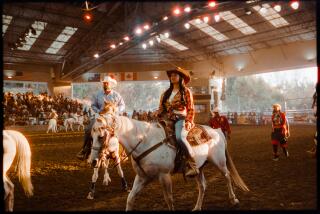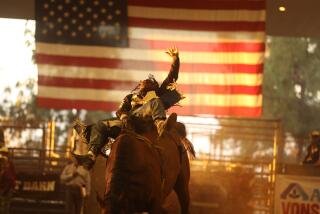Western Rodeos Included Indians as Well as Cowboys
- Share via
NEW YORK — The bone-jarring, head-banging sport of bronco busting seemed almost easy to Jackson Sundown after escaping on horseback from U.S. troops in the Nez Perce wars.
He was in his 50s when he reached rodeo’s pinnacle in 1916as the first American Indian to win the world bucking championship and hold the all-around title at the Pendleton Roundup.
“Sundown! Sundown! Ride ‘em, Sundown!” crowds yelled. His ride in Oregon made him one of rodeo’s early Indian heroes.
Tom Three Persons of the Kainai in Alberta, Canada, is another storied figure. He won the world saddle bronc title at the first Calgary Stampede in 1912.
Their exploits are described in “Legends of Our Times: Native Ranching and Rodeo Life on the Plains and Plateau,” a compelling exhibit at the Smithsonian’s National Museum of the American Indian in Manhattan.
The displays puncture a myth about separate, mutually hostile worlds of cowboys and Indians. In reality, they converged.
The collection of 700 relics encompasses antique saddles and bridles, buckskin attire and saddlebags, powwow regalia, headdresses, buffalo-skin overcoats, leather chaps, rifle cases and hunting-knife scabbards.
Photos of native ranching and rodeo exploits were gathered by the Canadian Museum of Civilization in Ottawa. Wallboards explain how Indian cowboys evolved from buffalo hunters to reservation ranchers, then respected rivals of white cowboys at rodeos.
“People tend to look at stereotypes, saying they didn’t realize that Indians could be cowboys,” said Gerald McMaster, museum deputy assistant director for cultural resources. “Native people have been contributing for hundreds of years.”
Ranching “was a natural crossover -- a way of life based on a horse culture, their experience of driving herds of deer and buffalo, their knowledge of the land for grazing,” he said.
The exhibit, which runs through March 7, 2004, is in the ornate former Customs House at Battery Park. Admission is free.
The survey begins with descriptions of the sacred role of horses, dogs and buffalo in Plains and Plateau tribal societies, and how these beliefs influenced native cowboys’ views of ranching and rodeo life.
Other installations describe the evolution of Indian ranching, rodeo events, native entertainers in Western films, music and pageants, and native artisans -- saddle makers, clothing designers and silversmiths.
Equestrian skills were a matter of life-or-death for the Plains people, essential for hunting buffalo and other game, and fending off marauding rivals. Arrival of white settlers led to bitter conflicts over land and the slaughter of buffalo herds, ending unfettered migration of tribes.
Confined to reservations, Indians found that horsemanship and other life-sustaining skills were ideal for cattle ranching. They became adept at roping calves, branding steers and growing hay for winter feed.
Many Indian cowboys hired out to the huge cattle drives that brought beef to eastern markets in the 19th century. When rodeo competitions blossomed in the early 20th century, Indian ranch hands were able to challenge white cowboys in such events as roping and bronco busting.
Sundown’s story is emblematic of resilience and adaptability. As a teenager in 1877, he joined Chief Joseph’s band in their flight from the Nez Perce reservation in Idaho, pursued by U.S. troops. At the Battle of Big Hole in Montana, Sundown escaped after hiding under buffalo robes in a tepee when the bluecoats set the camp afire, killing many women and children. After the Battle of Bear Paw Mountain, he escaped to Canada. He returned to Montana in the 1880s, mastered rodeo skills and began competing at 40.
More to Read
Sign up for The Wild
We’ll help you find the best places to hike, bike and run, as well as the perfect silent spots for meditation and yoga.
You may occasionally receive promotional content from the Los Angeles Times.






